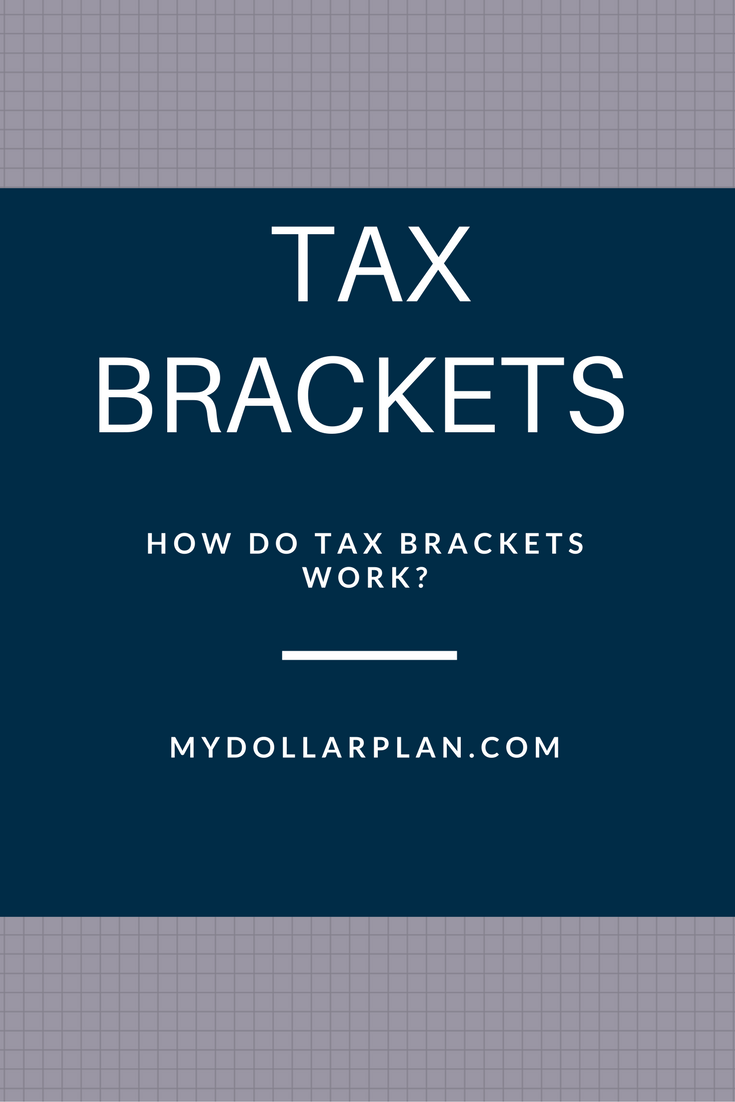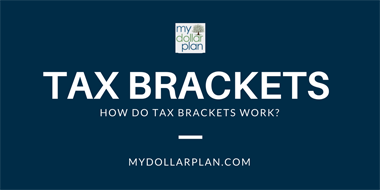How Do Tax Brackets Work?
Are you getting ready to file your taxes? If so, you might find yourself needing a slight refresher on how tax brackets work before the tax deadline.
The US tax system is based on a progressive rate structure – the more income you make, the higher tax rate you pay.
How Do Tax Brackets Work?
But contrary to popular belief, you do NOT pay the same tax rate on all of your income. Instead, your tax bracket tells you exactly how much tax you will owe on income falling within the limits for that tax bracket. Any income below the threshold for that bracket will be taxed at a lower rate. Confused? Read on.


Finding Your Tax Bracket
Federal tax brackets are based on income and filing status. Each taxpayer belongs to the 10%, 15%, 25%, 28%, 33%, 35% or 39.6% tax bracket. There is a minimum and maximum income for each bracket, as shown in the table below (all numbers refer to 2016 tax rates for returns due in 2017).
| Tax Rate | Single | Married Filing Joint | Married Filing Separate | Head of Household |
|---|---|---|---|---|
| 10% | Up to $9,275 | Up to $18,550 | Up to $9,275 | Up to $13,250 |
| 15% | $9,276 – $37,650 | $18,551 – $75,300 | $9,276 – $37,650 | $13,251 – $50,400 |
| 25% | $37,651 – $91,150 | $75,301 – $151,900 | $37,651 – $75,950 | $50,401 – $130,150 |
| 28% | $91,151 – $190,150 | $151,901 – $231,450 | $75,951 – $115,725 | $130,151 – $210,800 |
| 33% | $190,151 – $413,350 | $231,451 – $413,350 | $115,726 – $206,675 | $210,801 – $413,350 |
| 35% | $413,351 – $415,050 | $413,351- $466,950 | $206,676 – $233,475 | $413,351 – $441,000 |
| 39.6% | Over $415,050 | Over $466,950 | Over $233,475 | Over $441,000 |
To find your tax bracket, first locate your filing status across the top of the table (you can check your filing status if you’re not sure). Once you have located your filing status, locate your income in the appropriate column. Look to the far left to find your tax bracket.
For instance, if you are married, filing taxes jointly with your spouse and have a combined income of $100,000, you will fall into the 25% tax bracket. If you are single and have an income of $100,000, you will fall into the 28% tax bracket. This is referred to as your marginal tax rate.
Calculating Taxes
Once you have located your tax bracket, you can calculate your initial tax liability. You do not apply your tax rate to all of your income. Instead, you apply the appropriate rate for income in each bracket. So let’s say the married couple making $100,000 wants to see what they might owe this year.
- Calculate 10% of income up to $18,550. The couple makes more than $18,550, so calculate 10% of the full amount ($1,855).
- Calculate 15% of income between $18,550 and $75,300. Once again, the couple makes more than the maximum amount so calculate the entire potential tax. In this case, you have to subtract first: $75,300-$18,550 is $56,750. Then apply the 15% rate to get roughly $8,513.
- Calculate 25% of income between and $75,300 and $151,900. In this case, the couple makes $100,000 and does not need to calculate the potential tax on the full income covered by the 25% bracket. Instead, calculate $100,000 – $75,300 to get $24,700. Then multiply by 25% to get $6,175.
- Finally, add up all of the results from steps 1 -3. $1,855 + $8,513 + $6,175 = $16,543.
The couple could owe the IRS as much as $16,543 on their $100,000 in income. Note that even though they are in the 25% tax bracket they do not owe 25% of their income – instead they owe a maximum of 16.5%.
However, with deductions, exemptions and credits, their actual owed tax will likely end up being much less. The tax brackets are applied to your taxable income (not your gross income or salary you receive at work). To project your own tax liability (and potential refund), you can use our tax calculator.
Use Tax Brackets to Your Advantage
You can use the tax bracket thresholds to do a little tax planning. For instance, the couple above was making $100,000. In order to pay less than 25% on every single dollar of income, they would have to reduce income by nearly $25,000 – which is possible if they are taking full advantage of maxing out their 401ks (and catch-up contributions if eligible).
At the same time, they can make roughly $52,000 more and pay the same rate on their last dollar of income as they are paying now. Only once they hit $151,901 in income will they start paying 28% on their last dollar of income.
Shift Income into Different Years. If the couple above thinks they might bump up against the higher bracket in future years but have the chance to shift rental, investment, freelance (1099) or other income into the current year, they should do so. If they were making $150,000 in the current year and thought they would make less next year they might want to shift income out of the current year to avoid paying the higher rate. If they made just over $152,000 they might want to make some extra payments to incur deductions and thus remain in the lower bracket.
Consider Roth Conversions. You can use tax brackets to your advantage in other situations. For instance, if you know you are in a lower tax bracket this year than you will be in years to come, it’s a great time to consider a total or partial Roth IRA conversion. If you already converted and found yourself in a lower bracket than expected this year, you could reverse the conversion and then reconvert.
Harvest Investment Losses. You could also use your current and projected future tax brackets to help you decide when to harvest investment losses – take as much loss as possible (an amount equal to capital gains + $3,000) in years when you fall into a higher bracket.
Tax Filing Online
File your tax return online with TurboTax.
Do you understand how tax brackets work? How do you use them to your advantage in tax planning?
More Tax Topics
- How to Calculate Self Employment Tax
- How Long Does it Take to Get Your Tax Refund Back?
- How Much Money Do You Have to Make to File Taxes?
- Do Your Kids Need to File Taxes?
- What is the Marriage Tax Penalty?
- Do You Have to Pay Income Tax on Social Security?
- How Much is the Penalty for No Health Insurance?
- What is the Health Insurance Premium Tax Credit?
- Can You Sign a Tax Return for Someone Else?





I use the “fill up the bracket” approach to calculate the amount for the yearly Roth conversion.
I think this is one big reason people with large incomes invest in Real Estate, is it not? B/c they won’t have to pay taxes on money tied up in buildings?
The money you put down on a building (or to buy Inventory for a business) has already been taxed as Income UNLESS it came from a 1031 Exchange. If it did, then the original money earned to pay the Principal on the original property was previously taxed before you used it for that Down-Payment and later Principal Payments.
The money used to pay Principal AND interest on all buildings (or business loans)has already been taxed as Income.
The good news is that the Interest portion of the payment is Deductible and the really good news is that you can “Depreciate” the building by deducting roughly 3% of the value of the structure each year.
A $400,000 duplex might have a $100,000 lot with a $300,000 structure, so you can deduct $9,000 per year from your income.
The bad news is that when you sell it in 2034 for $800,000 you not only have to pay Capital Gains Tax on the $400K you “Made”, but you have to Recapture all those years of depreciation and essentially pay back the taxes you saved over the past 20 years.
The SCAM is that in 20 years it will take at least $800,000 to buy what $400,000 will in 2014 (in food, clothing, cars, vacations, etc) so you didn’t really “make” anything in Capital Gains. None-The-less the IRS will hit you for 25% and California will claim another 10% of your $400,000 in Gain”.
The only way RE works is if the Rent covers the the Mortgage, Repairs, Vacancies and what you could have earned with the Down-Payment. If that all pencils out then you can end up with a “free” building in 20 or 30 years.
When referring to your tax tables, are you referring to gross income or adjusted gross (i.e., taxable)income. Also, have the tax tables changed from CY 2011 to CY 2012? Your 2012 rate table infers that they have changed. I need to be using the correct tables for my 2012 pro forma.
Hi Frank,
Yes, the income included in the tax brackets changed from 2011 to 2012. You can see both years here: 2011-2012 Tax Brackets. The income refers to taxable income.
Re. the tax tables (which seem to have changed from 2011) does the income apply to gross or taxable income?